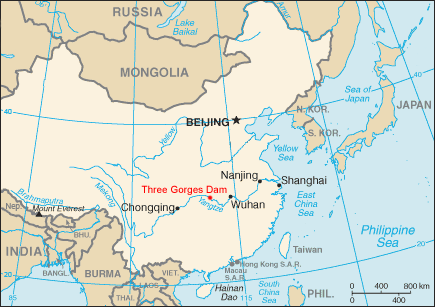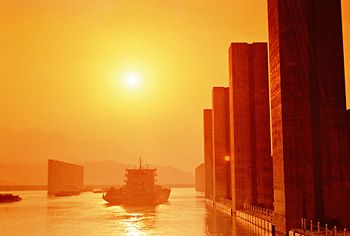Three Gorges Dam
The Three Gorges Dam (长江三峡大坝) is a large dam constructed by the Government of China on the Yangtze River near to Yichang City in Hubei Province. The dam is the widest structure of it's kind and the reservoir behind the dam will stretch for 600 kilometre (375 miles). The Yangtze has brought fertility to central China. However, it also has been the cause of frequent and devastating floods. Bringing the Yangtze under control has been a Chinese dream and the main objective of the dame design. Another justification has been making riverine transportation easier on the mid reaches of the river. Where the Yangtze passed through Qutang (瞿塘峡), Wuxia (巫峡) and Xiling (西陵峡) gorges, the river was treacherous with strong currents and dangerous rocks. The plans of the dam were augmented to include several large hydroelectric generators. When completed, they will have a capacity of generating 22.4 million kilowatt of power.
The project, which was budgeted to cost $25.2 Billion (203.9 Billion RMB), has seen significant objects. The river side population of 1.13 million people had to be relocated as cities, towns, villages and farms were demolished and submerged. New cities have been built above the old ones. Many cultural heritage sites sites have been lost to the rising waters. The Three Gorges was previously a major scenic area in China, and the view appears on the back of the 10RMB bank note. However, much of the drama of the deep gorges and fast moving river currents has been lost. There are additional worries over the effects of the dam on wildlife in the river.
The Chinese plans were that a system of locks would expedite water transport on the river.[1] When full the level of the water in the reservoir would extend all the way to Chongqing. Two sets of five conventional canal locks serve the river's vessels.
The canal locks are 280 meters (918 feet) long, 35 meters (114 feet) wide, and 5 meters (16.4 feet) deep.[2][3] That is 30 meters longer, than the St Lawrence Seaway, but half the depth. The canal locks are designed to handle 10,000 ton barges.[4]
In addition to the canal locks, the Three Gorges Dam will be equipped with a ship lift, a kind of elevator for vessels.[4] The ship lift will be capable of lifting ships of up to 3,000 tons.[5][6][7] In the original plan its capacity was to be 10,000 ton vessels.
The ship lift was not yet complete when the rest of the project was officially opened on May 20 2006.[8][9] On October 3 2006, China Daily predicted that the shiplift would be completed in 2008.[10]
References
- ↑ Yangtze as a vital logistics aid, China Economic Review, May 30 2007. Retrieved on 2007-06-03. (in Chinese)
- ↑ Three Gorges Dam. Missouri Chapter American Fisheries Society (April 20 2002). Retrieved on 2007-01-28.
- ↑ Its Buildings with Biggest Indices. China Three Gorges Project (2002). Retrieved on 2007-01-28.
- ↑ Jump up to: 4.0 4.1 Dorothea Krebs, Thomas Runte, Gerhard Strack. Planning of the ship lift at the Three Gorges dam in China. Retrieved on 2008-03-12.
- ↑ Three Gorges Shiplift resurfaces. Three Gorges Probe (November 7 2003). Retrieved on 2007-01-28.
- ↑ China's west seeks to impress investors, BBC, May 4 2005. Retrieved on 2007-01-28.
- ↑ Ship lift work to begin at Three Gorges site,. Three Gorges Probe (March 23 2005). Retrieved on 2007-01-28.
- ↑ Three Gorges dam ready to go, Taipei Times, May 21 2006. Retrieved on 2007-01-28.
- ↑ China Completes Three Gorges Dam, CBS News, May 20 2006. Retrieved on 2007-01-28.
- ↑ 300,000 more to be relocated from Dam region, China Daily, 3 October 2006. Retrieved on 2007-01-28.

